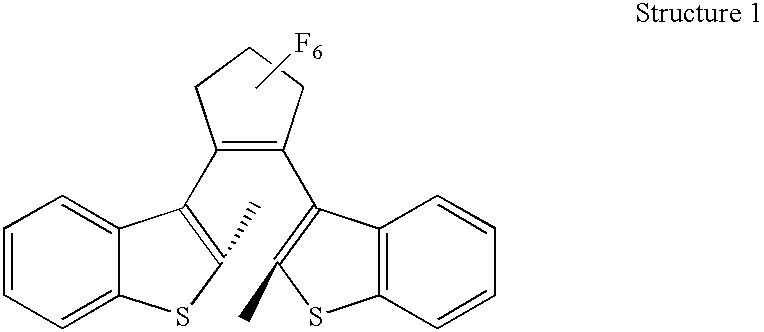Diarylethene derivatives and photochromic thin film prepared using the same
a technology which is applied in the field of diarylethene derivatives and photochromic thin films prepared using the same, can solve the problems of difficult to obtain homogeneous thin films, insufficient photochromic effects, and unclear films
- Summary
- Abstract
- Description
- Claims
- Application Information
AI Technical Summary
Problems solved by technology
Method used
Image
Examples
example 2
Preparation of 1-(6'-diphenyl acetyl-2'-methyl[b]thiophene-3'-yl)-2-(6"-di-phenyl acetyl-2"-methyl[b]thophene-3"-yl)hexafluorocyclopentene (Structure 11)
[0033] To a compound of structure 1 (1 g) dissolved in 40 mL of dry MC was added diphenylacetyl chloride (1.45 g). AlCl.sub.3 (0.85 g) was further added to the reaction mixture and reacted for 5 hours at room temperature. The reaction mixture was extracted with water and MC, and then an organic layer was washed with aqueous solutions of NaOH and NaCl, followed by drying over MgSO.sub.4. The dried organic layer was evaporated under the reduced pressure to remove solvent and the residue was purified by a flash column chromatography on silica gel (n-hexane / ethyl acetate=8 / 1 to 5 / 1) to obtain the desired compound of structure 11(1.56 g, 1.82 mmol) with 85% of yield.
[0034] .sup.1H NMR (200 MHz, CDCl.sub.3); .delta.2.18 (s, 3H), 2.44 (s, 3H), 7.16-7.58 (m, 28H)
example 3
Preparation of 1-(6'-(4,4-dimethyl-3-oxo-1-pentene)-2'-methylbenzo[b] thiophene-3'-yl)-2-(2"-methylbenzo[b]thophene-3"-yl)hexafluorocyclopenten-e (Structure 8)
[0035] Pinacolone (0.15 g) was dissolved in 10 mL of dry THF and 0.9 mL of lithium diisopropylamide (2.0 M) was added thereto at a temperature of 0 to -10.degree. C. After stirring the mixture for 1 hour, 1-(6'-formyl-2'-methyl benzo[b]thiophen-3'-yl)-2-(2"-methylbenzo[b]thophe-ne-3"-yl)hexafluorocyclopentene (FMBTFP) (0.5 g, 1.0 mmol) dissolved in 10 mL of dry THF was added to thereto. The reaction mixture was reacted for 3 hours at room temperature and then extracted with water and ethyl acetate. An organic layer was washed with an aqueous solution of NaCl, followed by drying over MgSO.sub.4. The dried organic layer was evaporated under the reduced pressure to remove solvent and the residue was purified by a flash column chromatography on silica gel (n-hexane / ethyl acetate=9 / 1) to obtain 1-(6'-(4,4-dimethyl-3-oxo-1-penten-yl...
example 4
Preparation of 1-(6'-benzoyl ethylene-2'-methylbenzo[b]thiophene-3'-yl)-2--(2"-methylbenzo[b]thophene-3"-yl)hexafluorocyclopentene (Structure 5)
[0037] Acetophenone (0.3 g) was dissolved in 20 mL of dry THF and 1.5 mL of lithium diisopropylamide (2.0 M) was added thereto at a temperature of 0 to -10.degree. C. After stirring the mixture for 1 hour, 1-(6'-formyl-2'-methylbenzo[b]thiophen-3'-yl)-2-(2"-methylbenzo[b]thophen-e-3"-yl)hexafluorocyclopentene(FMBTFP, 1.0 g) dissolved in 20 mL of dry THF was added to thereto. The reaction mixture was reacted for 3 hours at room temperature and then extracted with water and ethyl acetate. An organic layer was washed with an aqueous solution of NaCl, followed by drying over MgSO.sub.4. The dried organic layer was evaporated under the reduced pressure to remove solvent and the residue was purified by a flash column chromatography on silica gel (n-hexane / ethyl acetate=7 / 1) to obtain 1-(6'-benzoyl ethylene-2'-methylbenzo[b]thiophene-3'-yl)-2-(2"-m...
PUM
| Property | Measurement | Unit |
|---|---|---|
| Percent by mass | aaaaa | aaaaa |
| Percent by mass | aaaaa | aaaaa |
| Temperature | aaaaa | aaaaa |
Abstract
Description
Claims
Application Information
 Login to View More
Login to View More - R&D
- Intellectual Property
- Life Sciences
- Materials
- Tech Scout
- Unparalleled Data Quality
- Higher Quality Content
- 60% Fewer Hallucinations
Browse by: Latest US Patents, China's latest patents, Technical Efficacy Thesaurus, Application Domain, Technology Topic, Popular Technical Reports.
© 2025 PatSnap. All rights reserved.Legal|Privacy policy|Modern Slavery Act Transparency Statement|Sitemap|About US| Contact US: help@patsnap.com



